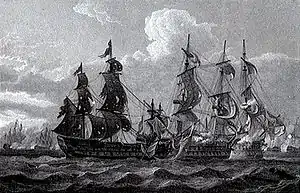Canada-class ship of the line
The Canada-class ships of the line were a series of four 74-gun third rates designed for the Royal Navy by William Bateley. The name ship of the class was launched in 1765.
 HMS Captain capturing the San Nicolas and the San Josef at the Battle of Cape St Vincent, 14 February 1797 | |
| Class overview | |
|---|---|
| Name | Canada |
| Operators | |
| Preceded by | Arrogant class |
| Succeeded by | Ramillies class |
| In service | 17 September 1765 - 1834 |
| Completed | 4 |
| General characteristics | |
| Type | Ship of the line |
| Length |
|
| Beam | 46 ft 9 in (14.25 m) |
| Propulsion | Sails |
| Armament |
|
Design
During this period in British naval architecture, the 74-gun third rates were divided into two distinct groupings: the 'large' and 'common' classes. The Canada-class ships belonged to the latter grouping, carrying 18-pounder guns on their upper gun decks, as opposed to the 24-pounders of the large class.
Service
HMS Captain, made famous for Nelson's actions at the Battle of Cape St Vincent, belonged to this class of ships.
Ships
- Builder: Woolwich Dockyard
- Ordered: 1 December 1759
- Launched: 17 September 1765
- Fate: Broken up, 1834
- Builder: Adams & Barnard, Deptford
- Ordered: 23 August 1781
- Launched: 11 December 1785
- Fate: Broken up, 1816
- Builder: Barnard, Deptford
- Ordered: 2 October 1782
- Launched: 1 June 1787
- Fate: Broken up, 1814
- Builder: Batson, Limehouse
- Ordered: 14 November 1782
- Launched: 26 January 1787
- Fate: Burned and broken up, 1813
References
- Lavery, Brian (2003) The Ship of the Line - Volume 1: The development of the battlefleet 1650–1850. Conway Maritime Press. ISBN 0-85177-252-8.
This article is issued from Wikipedia. The text is licensed under Creative Commons - Attribution - Sharealike. Additional terms may apply for the media files.